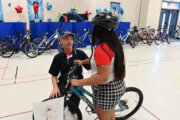Gym machines can help you attain your strength-building goals.
Gym machines are a staple for building lean muscle and burning fat. They can help you maintain proper form, gradually increase resistance and improve your range of motion.
According to the National Institute on Aging, there are many functional benefits of strength training for both men and women as they age, including:
— Improved mobility.
— Prevention of disability during the aging process.
— Maintained bone density.
— Enhanced results compared to aerobic exercise and diet alone in individuals with obesity trying to lose weight.
Thinking about venturing over to the weight room and wondering what machines to use at the gym? If you’re new to exercising, designing a new home gym or you’ve stuck to cardio and treadmills, strength training gym equipment may feel intimidating. You can’t go wrong with incorporating strength training in your routine, so here are nine gym machines you shouldn’t overlook when planning your workout.
1. Cable machine
Muscles trained with this gym machine: Any major muscle group.
Cable machines are one of the most sought-after machines at the gym. The cable machine is beginner friendly, so try this gym weight machine if you’re new to using strength training gym equipment.
“This piece of equipment is a versatile tool that provides you with a multitude of options,” says Cara Dobbertin, a physical therapist based out of Colorado and a team member at Practitionr, a content site to help medical practitioners navigate their careers or private practice.
You can target every major muscle group using the cable machine. Although other gym machines may be multipurpose, the cable machine also allows you to use different planes of motion and from different heights. This means you can work your muscles from all angles.
“With the wide selection of attachments, from bars to ropes and handles, you’re able to continually change up your workout,” Dobbertin notes.
It’s a piece of exercise equipment for individuals of any age or fitness level.
How to use a cable machine
Virtually any exercise that you can perform with a resistance band, you can perform on a cable machine. Try performing staple exercises such as:
— Back rows, which target the back muscles, such as the latissimus dorsi.
— Lat pulldowns, which target the latissimus dorsi.
— Chest presses, which target the chest muscles, such as the pectoralis.
— Flies, which target the chest and the shoulder muscles, such as the deltoids.
— Triceps extensions, which target the triceps.
— Biceps curls, which target the biceps.
— Wood chops, which target the core, such as the obliques.
Using this gym equipment as a cable crossover machine, you can target the pectoralis muscles, the main muscle group in the chest. There are endless cable machine exercises, so you can be creative when incorporating this gym machine into your workouts.
Common mistakes when using the cable machine
— Not adjusting the cables to the correct height for the exercise. Make sure you are achieving the full range of motion for your chosen exercise.
— Using momentum rather than being intentional about isolating the muscle through the exercise.
2. Hamstring curl machine
Muscles trained with this gym machine: Hamstrings.
The average American has weak hamstrings, which can lead to hamstring injuries. The hamstrings are a smaller muscle group than the quads, so they often don’t get as much attention when training. Strong hamstrings are essential for maintaining stability and protecting knee ligaments, like the ACL, which is a common victim of sports injuries.
Sports injuries can put a halt to your exercise routine, so injury prevention is key. And a hamstring curl machine is one of the easy-to-use gym machines that can strengthen your hamstrings big time.
How to use a hamstring curl machine
— Adjust the machine’s weights and pads so that you are sitting tall in the machine with your back firmly against the seat.
— Your knees should be in line with the machine’s axis, and the two leg pads should sit on the top of your thighs, just above your knees, and behind your ankles or lower calves, respectively.
— To complete the exercise, bend your knees to at least 90 degrees.
— Then slowly, and under control, return back to start.Make sure not to move your upper body or jolt the weight throughout the movement.
Common mistakes when using the hamstring curl machine
— Not staying stable against the machine’s pads. Throughout the movement, stay stable against the machine’s padding to prevent injury.
— Swinging your legs. Focus on the mind-muscle connection with your hamstrings, and use your muscles to move the weight.
3. High-row machine
Muscles trained with this gym equipment: Lats, biceps, rhomboids, trapezius and posterior delts.
The high-row is one of the gym machines that can help train the back and improve posture. Especially with the rise of remote and computer work, many individuals slouch or sit in imbalanced positions at their desks all day. Working the muscles in the back can prevent some of the issues that arise with poor posture.
Plus, strengthening your back and shoulders can help sculpt an hourglass figure by making the back and shoulders appear larger than the waist.
How to use a high-row machine
— Sit tall into the machine with your chest pressed firmly against the pad.
— Reach up at a 45-degree angle to grab the handlebars with both hands.
— Keeping your torso still and your feet flat on the floor, pull the handles toward your body by contracting your shoulders and pulling your elbows behind you.
— Once your hands reach the sides of your torso, pause, then slowly reverse the movement to return to start.
Common mistakes when using the high-row machine
— Not adjusting the seat properly. Ensure the seat is set at a height that allows you to fully extend your arms.
— Rounding your back. Keep an upright posture to avoid back strain.
4. Landmine
Muscles trained with this gym machine: Various muscle groups, depending on the exercise.
Don’t let the size scare you. Landmines are actually an ideal gym machine for beginners because they allow you to perform compound exercises — an exercise that uses multiple muscle groups — with an easily customizable amount of weight. A landmine is a pivot joint attached to the floor, with one end of a barbell inserted into it. This provides a range of motion with less safety risk than a traditional free barbell.
How to use a landmine machine
The landmine is another versatile piece of gym equipment, allowing you to perform both presses and squats. Make sure to use the landmine by itself before adding any additional weight.
The National Institute for Fitness and Sport suggests trying the following landmine exercises:
— Landmine back exercises, such as bent-over rows, trunk twists or a half-kneeling trunk twist.
— Landmine leg exercises, such as landmine Romanian deadlifts or sumo squats.
— Landmine shoulder exercises, such as shoulder presses or a half-kneeling press.
Common mistakes when using the landmine machine
— Not engaging your core, which can help you stay stabilized through the exercise.
— Improper grip. Ensure you are comfortable holding the landmine, which feels different than traditional dumbbells.
5. Assisted chin-up machine
Muscles trained with this gym machine: Abs, lats, traps, biceps, chest and delts.
You can use this gym equipment for either assisted chin-ups or assisted pull-ups. The difference between the two exercises lies in the grip. With a chin-up, your palms are facing you, and with a pull-up, your palms are facing away from you. Pull-ups and chin-ups are essential compound exercises to strengthen the pulling muscles in the body, which are generally weaker than the muscles used for pushing.
Since performing chin-ups and pull-ups unassisted can be very challenging, especially for women, these gym machines are a helpful alternative. And, even if you can already eke out a pull-up or two all by yourself, the machine allows you to get in muscle sets and reps for increased strength and muscle gains throughout your back, core, biceps and shoulders.
How to use an assisted chin-up machine
— Facing the gym equipment, grab the bar with your hands shoulder-width apart.
— Kneel with your shins on the bench (preset to your preferred “level of assistance”), and let your body hang, elbows straight but not locked out.
— Squeeze your back, and brace your core to pull your chest to the bar.
— Pause, then slowly lower your body in a controlled motion back to start.
Common mistakes when using the assisted chin-up machine
— Using momentum. It’s tempting to use momentum to finish the range of motion, but adjusting the counterbalance to keep your muscles fully engaged will prevent injury to your back and shoulders.
— Leaning back. Keep your back and core straight and upright.
6. Seated cable row
Muscles trained with this gym machine: Lats, rhomboids, trapezius, biceps and triceps.
The seated cable row is a compound exercise that works the back, shoulders and arms. Boosting these muscles helps prevent common shoulder injuries like rotator cuff tears. These gym machines typically come with multiple attachments you can use to target different muscles.
“Compound exercise, such as the seated cable row, allows you to get a full-body workout in less time, keeps your heart rate up to offer cardiovascular benefits and generally burns more calories. Because it simulates real-world movements, it helps to build strength for everyday living,” says Dr. Raj Dasgupta, a Los Angeles-based pulmonary, critical care and sleep medicine specialist and the chief medical advisor for Garage Gym Reviews, a home gym equipment review website.
How to use a seated cable row
When using the cable row machine, you’re targeting the upper body posterior chain, which includes muscles on the back of the body, like the lats, rear delts and rhomboids. It also activates the biceps and core.
Dasgupta explains the steps to use a seated cable row:
— Make sure to adjust the seat so that your knees are bent at a 90-degree angle.
— Grasp the handles with an overhand grip.
— Pull the handles back toward your chest, keeping your elbows close to your sides.
Common mistakes when using the seated cable row
— Relying on your arms. Focus on maintaining a mind-muscle connection with your back to stay fully engaged with the exercise.
— Not completing the range of motion. Try squeezing the shoulder blades at the end of the moment to get the most benefit from the exercise.
7. Smith machine
Muscles trained with this gym machine: Various muscle groups, depending on the exercise.
The Smith machine is a piece of gym equipment that can be used for a variety of exercises, including:
— Smith machine squat.
— Smith machine bench press.
— Smith machine deadlift.
— Smith machine row.
— Smith machine lunge.
— Smith machine hip thrusts.
Since the Smith machine offers stability and assists with balance, Dasgupta says it can be a good option for those who are beginners or those new to weightlifting, recovering from injuries or who have limited mobility. However, he warns that it does not allow for the same range of motion as a free barbell. This can lead to bad form if used incorrectly. Additionally, the supportive muscles, such as the core, don’t work as hard on the Smith machine as they would with a free barbell.
Dobbertin adds that the fixed path from a Smith machine can cause you to move in an unnatural motion. Not keeping proper form can lead to injuries like muscle strains or joint issues. So, make sure your form is solid before using a Smith machine, and don’t hesitate to ask gym personnel or a personal trainer for assistance.
How to use a Smith machine
To use the Smith machine for a squat:
— Stand under the bar with your feet shoulder-width apart.
— Squat down until your thighs are parallel to the ground.
To use the Smith machine for a bench press:
— Lie on a bench under the bar.
— Press the bar up to your chest.
— Keep your back straight throughout the entire movement, and avoid using momentum to lift the weight.
Common mistakes when using the Smith machine
— Not warming up. The Smith machine is used for compound exercises that engage large muscle groups. Warming up with less weight first will prevent injury and allow you to improve your strength over time.
— Not adjusting the bar height. Adjust the bar so it aligns with your chosen exercise and allows you to complete the full range of motion.
8. Leg press
Muscles trained with this gym machine: Glutes, calves, quads and hamstrings.
The standard leg press is one of the most common gym machines for good reason: It’s simple but effective, says Jenny Harkins, a certified group fitness instructor and the proprietor of five fitness facilities in the Chicago area.
“This is a great alternative to free weights because it’s easier on the joints,” she adds.
How to use a leg press
Using a leg press device is simple, Harkins says. Follow the steps below:
— Recline in the seat, keeping your back flat against the backrest.
— Place your feet in the foot base.
— Extend your legs, and lower the platform until your knees reach a 90-degree angle.
By simply moving the placement of your feet, you can target different muscle groups. Leg press foot placement does matter.
You can also use one leg for a single-leg press to target any muscle imbalances or use the leg press to perform a calf raise by positioning your feet at the bottom of the platform.
Common mistakes when using the leg press machine
— Locking your knees. Make sure to avoid fully locking out your knees at the top of the movement to avoid the risk of injury.
— Incorrect foot placement. “Place your feet higher on the foot base to target hamstrings and glutes or if you are looking to hit quads,” Harkins says.
9. Leg extension machine
Muscles trained with this gym machine: Quads.
The leg extension machine is an isolation machine used primarily to target the quads, one of the body’s largest muscle groups, located on the front of the legs. The quads are an essential muscle group, helping you perform everyday actions like sitting, jumping and walking up stairs. Strengthening the quads can make these daily activities easier and prevent atrophy that may make these motions difficult later in life.
How to use a leg extension machine
To use the leg extension machine:
— Adjust the machine so your legs are at a 90-degree angle while seated comfortably.
— Extend your legs as you move the weight, careful not to lock your knees at the full extension.
— Gently bring your legs back to their starting position.
Common mistakes when using the leg extension machine
— Uncontrolled eccentric (lowering) movements. After the top of the range of motion, don’t let your legs swing down. Control the speed at which your legs return to their starting position. This is to get the full benefit of the exercise as well as to prevent injury.
— Partially extending. While you don’t want to lock your knees at the top of the movement, be sure to fully extend your legs. If you can’t, lower the weight.
To recap, here are the gym weight machines you should use ASAP:
— Cable machine.
— Hamstring curl machine.
— High-row machine.
— Landmine.
— Assisted chin-up machine.
— Seated cable row.
— Smith machine.
— Leg press machine.
— Leg extension machine
More from U.S. News
Exercises Trainers Would Never Do
Best Exercises for Preventing Falls in Older Adults
A Guide to Exercise After Surgery
9 Gym Weight Machines You Should Start Using ASAP originally appeared on usnews.com
Update 02/23/24: This story was previously published at an earlier date and has been updated with new information.







